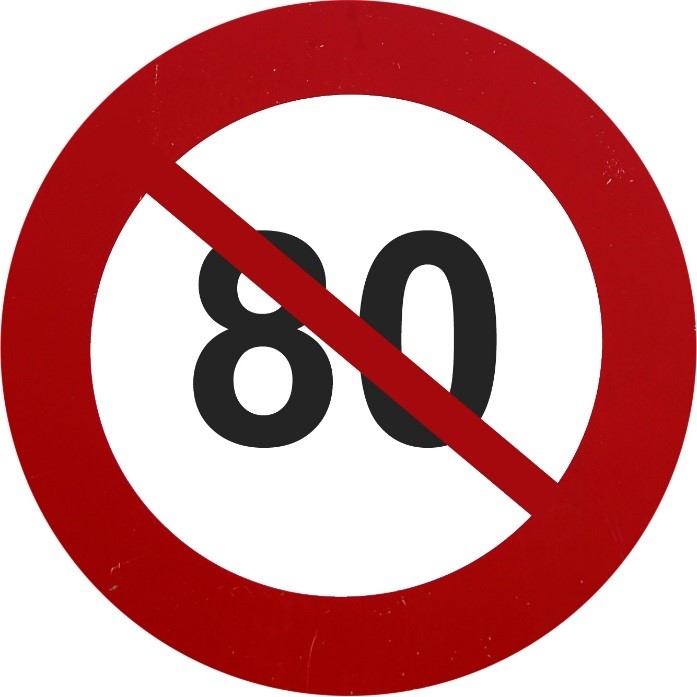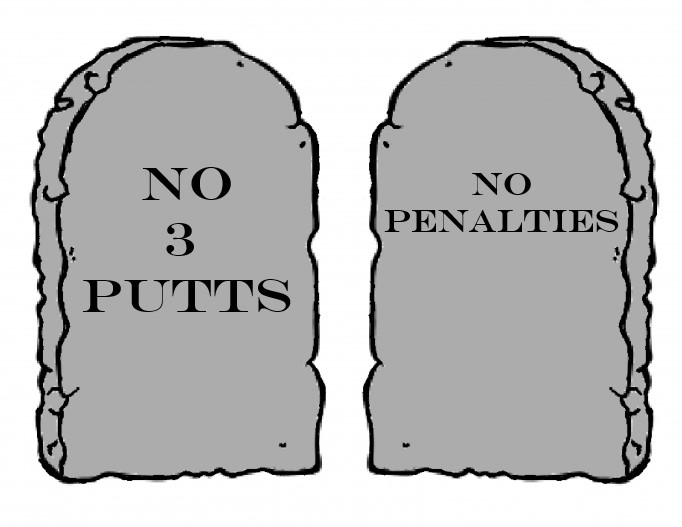Introduction
Congratulations, if you’re searching for tips on “How to Break 80,” you’re probably scoring in the mid to low 80’s consistently. That alone places you in rare company, but it’s time to get into the 70’s, and I’m going to help you do just that.
Let’s start with a simple realization:
79 = 11 pars + 7 bogeys
That’s it. You don’t need to set the world on fire, you just need to scrape it around and keep the big numbers off the card. To do that, you DO NOT need a new swing, you just need to upgrade your practice and improve your mental game.
Daniel’s Two Commandments
When trying to break 100, my Two Commandments are a suggestion. When trying to break 90, they’re a strong suggestion. When you’re trying to get into the 70’s, they’re almost mandatory.
Keep the ball in play and don’t three putt.
Upgrade Your Practice
Upgrading your practice doesn’t mean buying a bunch of new training aids, nor does it mean putting in more hours, it means getting more out of your hours. To do that, you need to approach your practice sessions with a clear plan of what you need to accomplish.
Know Your Distances and Your Percentages
As someone scoring in the 80’s, you probably have some idea of your yardages and percentages. Get a better one. You should know your average/comfortable yardage for each club as well as your maximum yardage. Of equal importance are your percentages: how often do you hit each club perfectly? How often are you successful in hitting your chosen shot shape or trajectory? This is the information you need to form a good game plan.
The 80% Rule
Once you know your percentages, you can put the 80% Rule into effect. Simply put: if you can’t execute a certain shot 80% of the time in practice, you should not attempt it on the course. That could mean that you don’t try to hit a high draw with your 4-iron, or it could mean the 4 iron comes out of your bag altogether.
Tee Shot Competence
In my plan for “How to Break 90”, I advocated leaving your driver, 3W, hybrid, and long irons at home. Unless you’re Bubba-long, that won’t work for breaking 80. That said, you don’t need to hit driver to break 80: you can easily do it with a fairway wood or hybrid depending on your length and the course you’re playing.
The key to breaking 80 is hitting it far enough while keeping it in play. Again, “far enough” is relative to the course you’re playing, but “keeping it in play” should be easy enough to understand.
Ultimately, you need a club that will put you in a position to go for the green most of the time without ever getting you into trouble. If that’s your driver, great. If that’s your 3W, fine. Find a tee shot club that you can rely on, and stick with it.
Develop a “Go To” Shot
In both your long game and your short game, you need a “go to” shot, a shot you can execute even under the crippling pressure of needing to make par on #18 for a 79.
Your “go to” shot should be very specific, for example, a high, left-to-right, 163 yard 7-iron. That level of specificity makes it a real “go to” shot. Saying that your 7-iron is your “go to” shot isn’t going to cut it because you will find yourself questioning how you will shape the ball and how far it will go.
With your short game shot, you want to know the club, the mechanics, and the expected trajectory of the shot. When I say “know the mechanics,” I simply mean that you should be able to verbalize what the shot feels like so that you can recreate it under pressure. For me, that would mean, “60° wedge, ball centered, quiet hands, left shoulder drives the club back and through.” That produces a shot I can hit up to 60 yards on a low trajectory with moderate roll out. It may not be the perfect shot for every situation, but I know I can execute it under any circumstance.
Better Putting Practice
We all like seeing the ball go in the hole and pouring in dozens of 4-footers is great for your confidence, but it does not replicate the challenges you will face on the course. The first step to better putting practice is to use one ball instead of multiple balls. This replicates on-course putting and forces you to focus more. Now, with one ball, do 18 holes worth of putting: drop the ball some distance from the hole, putt until you make it, repeat 17 times. Mix up the starting distances: give yourself some 10-15 foot birdie opportunities and some 40-50 foot putts as well.
Mental Skills
Why is a caddy so valuable? Because he does the thinking for you, free of ego or other concerns. Unfortunately, most of us don’t get to play with a caddy or a coach, so we have to do the thinking for ourselves. On the bright side, this becomes a built-in advantage for those of us who develop our mental skills since 99% of golfers don’t.
Know Your Game
I already mentioned knowing your distances and percentages. That’s a great start, but it’s the bare minimum of knowing your game.
What shots do you like hitting the most? What shots do you fear? What situations make you feel confident? When do you feel nervous or tense on the course? What are the things that have kept you from breaking 80 in the past?
All these questions should be answered literally, but also probed for deeper insights. For instance, I used to prefer chipping a 50-footer to putting it. That’s a surface level preference. On deeper examination, I realized that preference wasn’t based on my success with each approach but on the fact that I had lower expectations for my chips. By simply examining that preference, I was able to upgrade my course management and play to the actual percentages as opposed to hurting myself with an irrational decision.
By taking time to reflect and analyze, you can learn all there is to know about your game and put yourself on a path to real improvement. I strongly recommend the Vision 54 books for those who want to explore this in more detail.
Minimize Risk
“Minimax” is an idea that comes from game theory. It refers to a strategy that minimizes the maximum loss, and it can be a very helpful way to think on the golf course. I’m going to use the picture above to illustrate.
On a Par 5, you have hit your second shot to the position shown above. If you play a really good pitch, playing along Line A gives you a much shorter birdie putt than Line B. However, Line A also brings a lot of big numbers into play. If you hit it short, you’re in the water and re-playing the same shot again plus two strokes. Hit it long and you have a dicey sand shot that needs to be perfect, lest it ends up in the water. Along Line B, the huge numbers are virtually impossible: hit it short and you can 2 or 3 putt for par or bogey, hit it long and you can chip it on the green and 2 putt for an easy six.
Of course, every shot entails risk and has some bad possible outcomes, but by focusing on minimizing your maximum score, you can stack the odds in your favor.
Discipline
Do you know why 80 is the toughest “break” in golf? It’s because players at this level have just enough skill that they forget about being disciplined. They’ve pulled off enough miracle shots that they believe they have one more in the bag. Unfortunately, they’re usually wrong, and the result is a big number.
Having the discipline to play for the middle of the green, taking your medicine, punching out, or laying-up is the key to better course management. If you’re going to be swayed by your friends’ taunting or your own ego, you will be chasing this milestone for a long time.
Mental Practice
If you’re still reading, I’ll take that to mean that you agree with me about the importance of mental skills for golf. If we agree that mental skills are important, we should also agree that they’re worth practicing.
Visualization
Visualization is the most powerful mental tool we have. We can actually convince our mind that things have already happened if we imagine them richly enough. You know this to be true: call to mind a strong negative memory and feel your body go through the physical response as if it’s happening again. We all know the power of our imagination, but most of us fail to use it to our benefit. Separate yourself by imagining or remembering positive things about your game: perfectly struck shots, putts falling in the cup, and chips stopping next to the hole. You can even play an entire round of golf in your mind.
Practice Decision Making
The best way to make the tough decisions easier is to make them in advance. This can be part of your visualization practice. Imagine a tough situation: the ball hit a sprinkler head and bounced behind a tree. What are you going to do? In your mind, see that tiny little window that you could try squeezing the ball through, then visualize yourself ignoring that window and making the smart play back onto the fairway. Envision yourself laying up in a situation where going for it carries too much risk. Picture yourself aiming at the center of the green, away from sucker pins.
Routine
Whether you’re playing, practicing, or imagining, routine is key to creating consistency. Use the same pre-shot routine on the course that you use in your practice. See that same routine when you visualize. The routine should include both physical and mental elements: a key phrase is every bit as important as your waggle.
Game Day
When it’s time to get on the course and break 80, you should treat it just like any athlete treats a day of competition. Start with a good night of rest, good nutrition, and then get to the course with plenty of time to warm up.
Warm Up
Most players at this level have a routine that they like to use, whether that means starting on the range or starting at the putting green. Regardless of the order, make sure you do the following things:
Warm up your body with stretching and activity.
Observe your ball flight on the range. This is not the time to make swing changes, simply note your distances, shot shape, and the effect of the wind, temperature, and other factors.
Get a feel for the speed of the greens. This will be critical to both your putting and short game.
Play the Right Tees
I cannot stress this enough: breaking 80 is breaking 80, the yardage does not matter. If moving up a set of tees allows you to hit a more reliable club off the tee, do it. If it will improve your sight lines or angles from the tee or into the green, do it. Break 80 now, worry about doing it from the tips later.
Stick to the Plan
You’ve structured your practice, both physical and mental, around giving yourself the best chances for success. Don’t abandon that now. Ignore the hero shot to shoot the hero score.
In Case of Emergency
You will get in trouble. That’s the reality of golf. It’s virtually impossible to hit 14 fairways and 18 greens. This is OK because you don’t have to do either to shoot 79. Remember the minimax concept and keep in mind that you have 7 bogeys to “spend.” Even a double bogey is a good score if it prevents triple or worse.
One Shot at a Time
Finally, remember that at no point in the round can you shoot 79. All you can ever do is hit the shot in front of you. Give it your full attention.
Reach out to us at:
@ImagenGolf on Twitter







